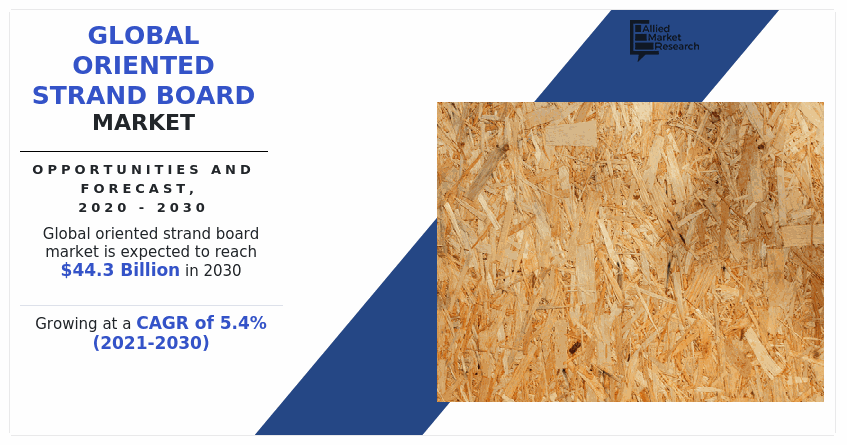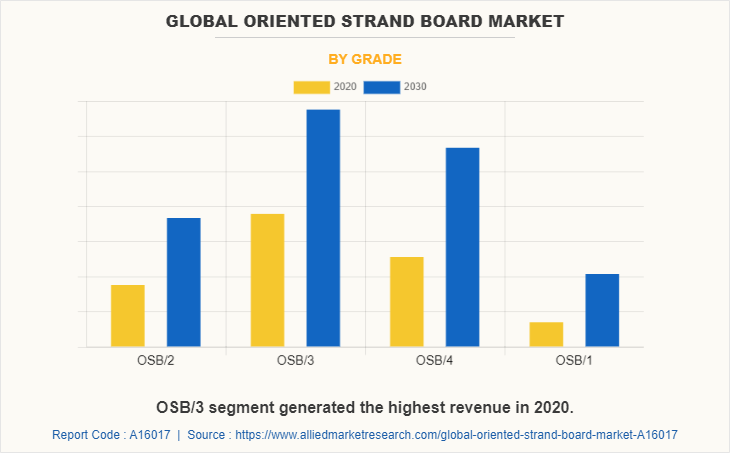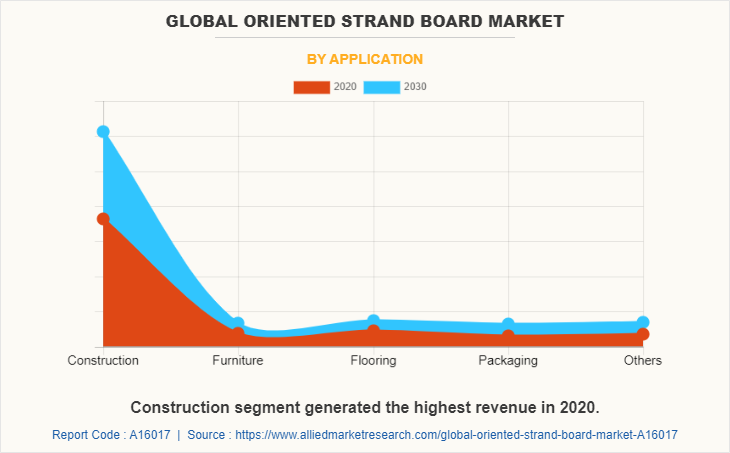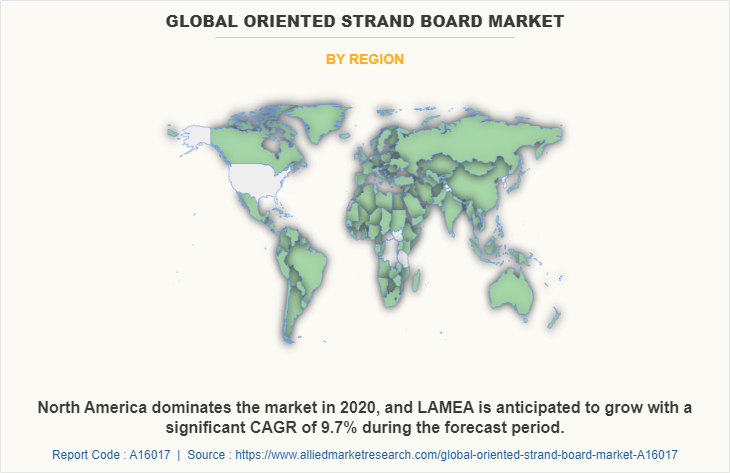Global Oriented Strand Board Market Research, 2030
The global oriented strand board market size was valued at $25.6 billion in 2020, and is projected to reach $44.3 billion by 2030, growing at a CAGR of 5.4% from 2021 to 2030.

Market Introduction and Definition
Oriented strand board is a widely used, versatile engineered wood board made from waterproof, heat curing adhesives, and rectangular shaped strands of wood arranged in cross-oriented layers. It is a type of engineered wood. OSB is manufactured in various grades with improving resistance to the effects of moisture. The combination of wood and adhesives in OSBs creates a strong, dimensionally stable panel that resists deflection, delamination, and distorting. Moreover, these panels resist racking and shape distortion when subjected to demanding wind and seismic conditions.
Increase in demand for eco-friendly and sustainable products in developed countries such as the U.S., France, and Germany boost oriented strand board market growth. Green building materials are expected to have a positive on product demand as they are preferred in the construction industry, due to their low emission rates. For instance, in North America, the U.S. Green Building Councils ensures that buildings in the country are sustainable and utilize green materials for construction purposes through Leadership in Energy and Environmental Design (LEED) , which is the leading program for green buildings.
Oriented strand board is used as an alternative for steel and concrete building material. The latest technology used to manufacture oriented strand board has made it strong, stiff, and durable in strength as well as lighter in weight and cheaper in cost. It also enhances the looks of the buildings when properly designed and installed. Moreover, there has been a rise in construction of green buildings, which are constructed and operated with minimum carbon emission. These advantages of oriented strand board have made it very popular among the builders and architects as an alternative for traditional steel and concrete building material, drive the growth of the oriented strand board market.
Further, increase in construction of green buildings is the major factor that boosts the growth of the oriented strand board market in the U.S. and Canada. Over 60% of the new building construction is expected to be of green buildings by 2025 in the U.S. and Canada. Moreover, the construction market in Mexico is rapidly adopting the green building trend as well. Owing to this, oriented strand board products has witnessed a growth of over 25% in the last five years.
Major players such as Collite, Egger Hozwerkstoffe GmbH, Koch Industries and West Fraser and others are adopting the product launch & acquisition to improve their product portfolio to maintain competition in the market. For instance, October 2020, Louisiana Pacific Corporation announced a new brand named, LP WeatherLogic Air & Water Barrier, an APA Structural I Rated wall and roof sheathing. Helpful for framing and sheathing solutions and achieve a tight building envelope. Such instances are expected to provide lucrative opportunities for the major players for the growth of the market.
Market Segmentation
The global oriented strand board market is segmented into grade, application, and end users. Based on grade, the market is categorized into OSB/1, OSB/2, OSB/3 and OSB/4. Currently, the OSB/3 segment dominates the global oriented strand board market share.

On the basis of application, the market is categorized into construction, flooring, packaging and others. Construction segment dominates the market in 2020, and flooring segment is anticipated to grow with a significant CAGR of 5.7% during the oriented strand board market forecast.

On the basis of end-user, the market is categorized into residential and non-residential. Residential segment dominates the market in 2020, and is projected to grow with a highest CAGR of 5.7% during the forecast period.
On the basis of region, the oriented strand board industry is analyzed across North America, Europe, Asia-Pacific, and LAMEA. North America region dominate the market, and followed by Europe. Asia-Pacific is predicted to grow faster than LAMEA with a CAGR of 4.8% during the forecast period.

Key Benefits For Stakeholders
- This report provides a quantitative analysis of the market segments, current trends, estimations, and dynamics of the global oriented strand board market analysis from 2020 to 2030 to identify the prevailing global oriented strand board market opportunities.
- The market research is offered along with information related to key drivers, restraints, and opportunities.
- Porter's five forces analysis highlights the potency of buyers and suppliers to enable stakeholders make profit-oriented business decisions and strengthen their supplier-buyer network.
- In-depth analysis of the global oriented strand board market segmentation assists to determine the prevailing market opportunities.
- Major countries in each region are mapped according to their revenue contribution to the global market.
- Market player positioning facilitates benchmarking and provides a clear understanding of the present position of the market players.
- The report includes the analysis of the regional as well as global oriented strand board market trends, key players, market segments, application areas, and market growth strategies.
Global Oriented Strand Board Market Report Highlights
| Aspects | Details |
| By Grade |
|
| By Application |
|
| By End User |
|
| By Region |
|
| Key Market Players | Weyerhaeuser Company, Koch Industries (Georgia Pacific), Egger Holzwerkstoffe GmbH, Kronospan Ltd, swiss krono group, West Fraser, Louisiana Pacific Corporation, coillte, sonae industria, tolko industries |
Analyst Review
According to insights of CXOs of leading companies, the oriented strand board market is mainly driven by rise in construction of sustainable houses. In addition, cost-effective and eco-friendly alternatives to other wood and cement products drive the market growth.
The construction and furniture industry are expected to have the largest market share in 2020. The oriented strand board market was valued at $25,550.2 million in 2020, and is expected to reach $44,320.8 million by 2030, registering a CAGR of 5.4% from 2020 to 2030.
According to the Engineered Wood Association, new home construction is the primary end user for the oriented strand board market in North America. Rise in adoption of oriented strand board in residential and non-residential construction fuels growth of the global oriented strand board market. Rise in need for oriented strand boards in various industry verticals such as foods & beverages, pharmaceuticals, and cosmetics propels demand for oriented strand boards.
However, fluctuating raw material prices can act as restraint for the oriented strand board market. In addition, rental and leasing services also restrict sales of new land equipment. On the contrary, urbanization in developing countries is the major factor for the oriented strand board market growth during the forecast period. Moreover, rise in construction related activities globally, is expected to provide lucrative opportunities for growth of the oriented strand board market.
Major companies in the market have adopted strategies such as acquisition, agreement, business expansion, and product launch to offer better services to customers in the oriented strand board market.
Growing construction related activities globally, which drive the growth of the market.
Construction segment generated the highest revenue in 2020.
North America region dominates the market in 2020.
The global oriented strand board market was valued at $25,550.2 million in 2020, and is projected to reach $44,320.8 million by 2030, growing at a CAGR of 5.4% from 2020 to 2030.
The key players operating in this market include include Coillte, Egger Hozwerkstoffe GmbH, Koch Industries, and Kronospan Ltd.,
Loading Table Of Content...


